|
|
1958 Geneva Conventions on the Law of the Sea
Geneva, 29 April 1958
- Introductory Note
- Procedural History
- Documents
- Status
- Photo
By Tullio Treves
Judge of the International Tribunal for the Law of the Sea,
Professor at the University of Milan, Italy
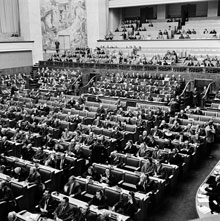 On 29 April 1958, as recorded in the Final Act (A/CONF.13/L.58, 1958, UNCLOS, Off. Rec. vol. 2, 146), the United Nations Conference on the Law of the Sea opened for signature four conventions and an optional protocol: the Convention on the Territorial Sea and the Contiguous Zone (CTS); the Convention on the High Seas (CHS); the Convention on Fishing and Conservation of the Living Resources of the High Seas (CFCLR); the Convention on the Continental Shelf (CCS); and the Optional Protocol of Signature concerning the Compulsory Settlement of Disputes (OPSD). The CTS entered into force on 10 September 1964; the CHS on 30 September 1962; the CFCLR on 20 March 1966; the CCS on 10 June 1964; and the OPSD on 30 September 1962. States bound by the Conventions and the Protocol, are, as at 23 July 2008, respectively: for the CTS, 52; for the CHS, 63; for the CFCLR, 38; for the CCS, 58; and for the OPSD, 38. On 29 April 1958, as recorded in the Final Act (A/CONF.13/L.58, 1958, UNCLOS, Off. Rec. vol. 2, 146), the United Nations Conference on the Law of the Sea opened for signature four conventions and an optional protocol: the Convention on the Territorial Sea and the Contiguous Zone (CTS); the Convention on the High Seas (CHS); the Convention on Fishing and Conservation of the Living Resources of the High Seas (CFCLR); the Convention on the Continental Shelf (CCS); and the Optional Protocol of Signature concerning the Compulsory Settlement of Disputes (OPSD). The CTS entered into force on 10 September 1964; the CHS on 30 September 1962; the CFCLR on 20 March 1966; the CCS on 10 June 1964; and the OPSD on 30 September 1962. States bound by the Conventions and the Protocol, are, as at 23 July 2008, respectively: for the CTS, 52; for the CHS, 63; for the CFCLR, 38; for the CCS, 58; and for the OPSD, 38.
The Conventions and Protocol are the product of the (first) United Nations Conference on the Law of the Sea, held in Geneva from 24 February to 27 April 1958. The convening of the Conference (by United Nations General Assembly resolution 1105 (XI) of 21 February 1957) was the culmination of a long process. It had its precedents in the work of the Hague Conference for the Codification of International Law held in 1930 under the auspices of the League of Nations. This Conference dealt with the territorial waters. Although not agreeing on the breadth of the territorial sea, it could present in its report 13 draft articles setting out a measure of agreement on many aspects of this subject. These articles would become the basis of further work. In the framework of the United Nations, the International Law Commission (ILC) indicated since the beginning of its work, in 1949, the regime of the high seas and of the territorial sea among the topics ripe for codification. A Special Rapporteur was designated, who proceeded to submit reports on various aspects of the law of the sea.
Up to the end of its work, in 1956, the ILC, and the General Assembly, which closely followed its work, proceeded through several drafts concerning different aspects of the law of the sea. It was only in the final report submitted to the General Assembly in 1956 that all provisions were systematically ordered as one body of draft articles covering the whole of the law of the sea. This final report was to be the main basis for the work of the 1958 Geneva Conference.
The Conference, whose task was “to examine the law of the sea, taking account not only of the legal but also of the technical, biological, economic and political aspects of the problem and to embody the results of its work in one or more international conventions or such other instruments as it may deem appropriate” (resolution 1105 (XI) referred to above), did not succeed in keeping the provisions on the law of the sea in one instrument. The unity of the law of the sea, painstakingly reached at the final stages of the work of the ILC, was lost (such unity was to be one of the main objectives pursued and reached in the 1982 United Nations Convention on the Law of the Sea). The adoption of four conventions and a protocol in lieu of one all-encompassing convention may be seen, and was conceived, as a device to attract the acceptance by a broad number of States of at least some of the Conventions, in this way avoiding very radical reservations, or the decision by certain States not to accept an all-encompassing convention because of opposition to one or more of its main component parts. The fact that the CFCLR and the OPSD have attracted a number of ratifications and accessions substantially lower than the other Conventions indicates that this Convention and Protocol were seen as controversial by States that considered the other Conventions acceptable. Significant absences in the groups of States having ratified the CTS and the CCS indicate specific difficulties, for instance as regards innocent passage through straits or the regime of the continental shelf.
Attended by 86 States, the Conference organized itself in five main committees and a plenary, and followed rules of procedure similar to those of the United Nations General Assembly, so that while provisions could be adopted in one of the committees by simple majority, a two-thirds majority was required when the provision reached the plenary. This procedural rule made it impossible to agree on the breadth of the territorial sea. Although a 12 mile breadth probably could have secured approval in the committee, it was clear that it could not do so in plenary, thus the question was left unresolved by the CTS. The fact that this Convention provides that the external limit of the contiguous zone can not exceed 12 miles from the baseline indicates that no breadth beyond 12 miles was seen as acceptable.
The United Nations General Assembly considered this key unresolved question, together with that of fishing limits, worthy of a further effort at reaching agreement and made them the main items on the agenda of the Second United Nations Conference on the Law of the Sea, held in Geneva from 16 March to 26 April 1960. This Conference failed to fulfil its objective. Among the various proposals, ranging from 3 to 200 miles maximum limits, a proposal for a 6 miles breadth of the territorial sea plus a 6 miles fishery zone immediately adjoining it was accepted in the Committee of the Whole but did not obtain the necessary two-thirds majority in plenary.
The CTS sets out in detailed provisions the main rules on the territorial sea and the contiguous zone. Its rules address, in particular, baselines, bays, delimitation between States whose coasts are adjacent or face each other, innocent passage and the contiguous zone. Among the aspects that at the time were seen as the most controversial were those related to article 16. First, article 16, paragraph 4, provides that innocent passage, which cannot be suspended, applies in straits used for international navigation not only connecting one part of the high seas to another part of the high seas, but also to the territorial sea of a foreign State, thus including also the strait of Tiran. Second, in article 16, no distinction is made regarding innocent passage of warships, hence the provision is generally couched for all ships. This outcome resulted from the fact that the States in favour of requiring the coastal State's consent did not vote alongside those who favoured prior notification.
The CHS defines the high seas as all parts of the sea not included in the territorial sea and internal waters. It deals specifically with: the freedoms of the high seas; the right of a State to have ships flying its flag under conditions fixed by it, stating the controversial requirement of the existence a “genuine link”; the rights and obligations of the flag State; piracy; the right of visit; hot pursuit; and the laying of submarine cables and pipelines. It also contains two early and pioneering provisions on pollution by the discharge of oil and of radio-active wastes.
The CFCLR sets out principles and mechanisms for the rational management of fisheries in the high seas. It insists on cooperation between States engaged in the same fisheries, it recognizes the special interest of the coastal State when the fisheries are in the high seas adjacent to its territorial sea and provides for compulsory settlement of disputes concerning all the key rules. Some of the provisions are similar to those that were to be adopted in 1995 in the United Nations Fish Stocks Agreement. At the time, the CFCLR was very controversial, as is evidenced from the low number of ratifications and accessions: on one hand, many States were keen on developing exclusive fishery rights beyond the territorial sea – a regime for fisheries on the high seas beyond the external limit of the territorial sea was not satisfactory; on the other hand, the central role given to the compulsory settlement of disputes was something that States were not ready for at the time.
The CCS sets out rules on the notion, limits and regime of the continental shelf. The basic concept of the sovereign right of the coastal State as regards resources of an area of the seabed beyond the external limit of the territorial sea had emerged in State practice only since 1945. It has been rightly said that the Convention “crystallizes” a relatively quick process of formation of a customary rule, which also includes the notion that the rights of the coastal State over the shelf do not require occupation or express proclamation. The provision on the external limit, based on the 200 meters isobath and on exploitability, was to be seen as obsolete in light of technological progress and was radically modified in the 1982 Convention. The rule on delimitation, based on the equidistance plus special circumstances concept, was clearly indicated by the International Court of Justice (ICJ) as not corresponding to customary law (North Sea Continental Shelf, Judgment, I.C.J Reports 1969, p. 42, para. 69). It is noteworthy, however, that recent developments in the ICJ case law on delimitation have brought the Court to accept an “equitable principles/special circumstances” method which, as recognized by the Court, is “very similar” to the equidistance/special circumstances method of the CCS (Land and Maritime Boundary between Cameroon and Nigeria (Cameroon v. Nigeria: Equatorial Guinea intervening), Judgment, I.C.J. Reports, I. C. J. Reports 2002, p. 441, paragraph 288).
The OPSD, to which only States parties to at least one of the Geneva Conventions can become party, provides for compulsory jurisdiction of the ICJ for all disputes concerning the interpretation or application of the Conventions, unless the parties to the dispute agree to arbitration or conciliation. This Protocol has never been applied in practice, and the modest number of parties it has attracted shows that compulsory settlement of disputes in law of the sea matters, if it is to be practically relevant, must be an integral part of the instrument dealing with the substance; a lesson learned by the Third United Nations Conference on the Law of the Sea (1973-1982) in drafting the 1982 Convention.
The importance of the Geneva Conventions is currently mostly historical, as an expression of the “traditional law of the sea”, namely, the law prevailing before the transformations in the international community and in its assessment of the uses of the seas that brought about the Third United Nations Conference on the Law of the Sea. The Conventions were adopted less than a decade before the famous speech by Arvid Pardo at the General Assembly in 1967 that started the process for the complete renewal of the law of the sea, and entered into force just a few years before that event. This explains why, notwithstanding their intrinsic legal quality, they were soon seen by a majority of the States as obsolete. Under article 311, paragraph 1, of the United Nations Convention on the Law of the Sea of 1982, the 1982 Convention “shall prevail, as between States Parties, over the Geneva Conventions on the Law of the Sea of 29 April 1958”. The 155 parties to the 1982 Convention include most of the States bound by the Geneva Conventions; the latter Conventions remain binding only as between, or in the relationships with, the few States that are parties to the relevant Geneva Convention and not parties to the 1982 Convention. This is, in particular, the case of the United States, Colombia, Israel and Venezuela.
Many provisions of the Geneva Conventions, at the time of their adoption, corresponded to customary international law. This seems particularly true as regards the CHS, most of which has been transported into the 1982 Convention, and whose preamble explicitly specifies that its purpose is “to codify the rules of international law relating to the high sea”. This provision is not repeated in the other Geneva Conventions. Still, a number of provisions in the CTS are set out in the 1982 Convention and can be seen as corresponding to customary law. Moreover, the basic provisions of the CCS, as remarked above, have been indicated as contributing to the “crystallization” of the customary notion of the continental shelf and still correspond to customary law.
This Introductory Note was written in September 2008.
Related Materials
A. Legal Instruments
United Nations Convention on the Law of the Sea, Montego Bay, 10 December 1982, United Nations, Treaty Series, vol. 1833, p. 3.
Agreement for the Implementation of the Provisions of the United Nations Convention on the Law of the Sea of 10 December 1982 relating to the Conservation and Management of Straddling Fish Stocks and Highly Migratory Fish Stocks, New York, 4 August 1995, United Nations, Treaty Series, vol. 2167, p. 3.
B. Jurisprudence
International Court of Justice, North Sea Continental Shelf, (Federal Republic of Germany/Netherlands), (Federal Republic of Germany/Denmark), Judgment, I.C.J. Reports 1969, p. 3.
International Court of Justice, Land and Maritime Boundary between Cameroon and Nigeria (Cameroon v. Nigeria: Equatorial Guinea intervening), Judgment, I.C.J. Reports 2002, p. 303.
C. Documents
League of Nations, Acts of the Conference for the Codification of International Law, (LN. doc. C.351.M.145, 1930, V.); Report of the Second Commission, League of Nations Publication V. Legal, 1930.V. 9 (C.230, M. I 17, 1930. V).
Yearbook of the International Law Commission, 1949, (A/CN.4/13 and Corr. 1-3), chapter II, p. 281.
Yearbook of the International Law Commission, 1956, vol. II, document A/3159.
Official Records of the United Nations Conference on the Law of the Sea, Geneva, 24 February-27 April 1958, (A/CONF.13/L.58), vol. 2, p. 146.
Official Records of the Second United Nations Conference on the Law of the Sea, Geneva, 17 March-26 April 1960, Annexes, (A/CONF.19/L.15, annex).
At its first session, in 1949, the International Law Commission selected both the regime of the territorial waters and that of the high seas as topics for codification, and included the latter in the list of topics to be given priority. Following a recommendation by the General Assembly in resolution 374 (IV) of 6 December 1949, the topic of territorial waters was added to the list of prioritized topics in 1951. The mandate of Mr. François, appointed Special Rapporteur for the topic of the high seas in 1949, was extended to include also the topic of the territorial sea. The topics were considered by the Commission at its second to eighth sessions, from 1950 to 1956 respectively, on the basis of the reports of the Special Rapporteur, information provided by Governments and International Organizations, as well as documents prepared by the Secretariat. Final drafts with regard to the continental shelf, fisheries and the contiguous zone were submitted by the Commission to the General Assembly at its fifth session, in 1953. The General Assembly decided, however, in resolution 798 (VII) of 7 December 1953, to defer all action until the problems relating to both the high seas and territorial waters had been studied by the Commission. The question of the continental shelf was brought before the General Assembly by ten Member States at the sixth session, in 1954, but the Assembly again deferred all action in resolution 899 (IX) of 14 December 1954, and requested the Commission to submit its final report on the regime of the high seas, the regime of territorial waters and all related problems to the Assembly by its eleventh session, in 1956.
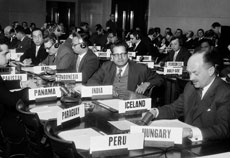 In 1956, the Commission adopted its final report on the territorial sea. At the same session, all the draft articles concerning the law of the sea were included in a single systematic body as to constitute a final draft on the law of the sea. The draft was submitted to the General Assembly with a recommendation to convene a conference of plenipotentiaries (see the report of the International Law Commission on the work of its eighth session, A/CN.4/104). Following the adoption of resolution 1105 (XI) of 21 February 1957, the United Nations Conference on the Law of the Sea, at which eighty-six states participated, was convened in Geneva from 24 February to 27 April of 1958. In accordance with the resolution, the mandate of the Conference was to examine the law of the sea in light of not only legal but also technical, biological, economic and political aspects of the problems involved, and to embody its results in one or more conventions or other appropriate instrument. In 1956, the Commission adopted its final report on the territorial sea. At the same session, all the draft articles concerning the law of the sea were included in a single systematic body as to constitute a final draft on the law of the sea. The draft was submitted to the General Assembly with a recommendation to convene a conference of plenipotentiaries (see the report of the International Law Commission on the work of its eighth session, A/CN.4/104). Following the adoption of resolution 1105 (XI) of 21 February 1957, the United Nations Conference on the Law of the Sea, at which eighty-six states participated, was convened in Geneva from 24 February to 27 April of 1958. In accordance with the resolution, the mandate of the Conference was to examine the law of the sea in light of not only legal but also technical, biological, economic and political aspects of the problems involved, and to embody its results in one or more conventions or other appropriate instrument.
Four separate conventions were adopted by the Conference on 29 April 1958 and were opened for signature until 31 October 1958, and thereafter opened for accession by all Member States of the United Nations, as well as other States and specialized agencies invited by the General Assembly to become party: the Convention on the Territorial Sea and the Contiguous Zone (entered into force on 10 September 1964); the Convention on the High Seas (entered into force on 30 September 1962); the Convention on Fishing and Conservation of the Living Resources of the High Seas (entered into force on 20 March 1966), and the Convention on the Continental Shelf (entered into force on 10 June 1964). In addition, an Optional Protocol of Signature concerning the Compulsory Settlement of Disputes was adopted, which entered into force on 30 September 1962.
Selected preparatory documents
(in chronological order)
Report of the International Law Commission on the work of its first session (A/CN.4/13 and Corr. 1-3, 12 April 1949)
General Assembly resolution 374 (IV) of 6 December 1949 (Recommendation to the International Law Commission to include the regime of the territorial sea in its list of topics to be given priority)
Memorandum presented by the Secretariat, “Regime of the High Seas. Questions under Study by other Organs of the United Nations or by Specialized Agencies” (A/CN.4/30, 23 June 1950)
Memorandum presented by the Secretariat, “Regime of the High Seas” (A/CN.4/32, 14 July 1950 (French only))
Laws and Regulations on the Regime of the High Seas, published by the Division for the Codification and Development of International Law (1950). U.N. Doc. ST/LEG/SER.B/2 (United Nations publication, Sales No. 1952.V.1) and U.N. Doc. ST/LEG/SER.B/1 (United Nations publication, Sales No. 1951.V.2)
Report by the Special Rapporteur Mr. François on the Regime of the High Seas (A/CN.4/17, 17 March 1950 (French only))
Report of the International Law Commission to the General Assembly on the work of its second session, 5 June – 25 July 1950 (A/1316)
Second Report of the Special Rapporteur Mr. François on the Regime of the High Seas (A/CN.4/42, 10 April 1951 (French only))
Report of the International Law Commission to the General Assembly on the work of its third session, 16 May to 27 July 1951 (A/1858)
Third Report of the Special Rapporteur Mr. François on the Regime of the High Seas (A/CN.4/51, 28 February 1952 (French only))
Report of the Special Rapporteur on the Regime of the Territorial Sea (A/CN.4/53, 4 April 1952 (French only))
Report of the International Law Commission to the General Assembly on the work of its fourth session, 4 June-8 August 1952 (A/2163)
Fourth Report of the Special Rapporteur Mr. François on the Regime of the High Seas (A/CN.4/60, 19 February 1953 (French only))
Second report of the Special Rapporteur on the Regime of the Territorial Sea (A/CN.4/61 and Add. 1, 19 February 1953 (French only))
Fifth Report of the Special Rapporteur Mr. François on the Regime of the High Seas (A.CN.4/69, 5 May 1953 (French only))
Report of the International Law Commission to the General Assembly on the work of its fifth session, 1 June-14 August 1953 (A/2456)
General Assembly resolution 798 (VIII) of 7 December 1953 (Regime of the High Seas)
Third report of the Special Rapporteur containing a further revised draft regulation including changes made in the light of observations of a group of technical experts (A/CN.4/77, 4 February 1954 (French only))
Sixth Report of the Special Rapporteur Mr. François on the Regime of the High Seas (A.CN.4/79, 1954 (French only))
Report of the International Law Commission to the General Assembly on the work of its sixth session, 3 June-28 July 1954 (A/2693)
General Assembly Resolution 899 (IX) of 14 December 1954 (Draft articles on the continental shelf).
Comments by Governments on the Provisional Articles concerning the Regime of the High Seas and the Draft Articles on the Regime of the Territorial Sea adopted by the International Law Commission at its Seventh Session (A/CN.4/99 and Adds. 1-9, 1955)
Report of the Special Rapporteur on both the regime of the high seas and the regime of the territorial sea (A/CN.4/97 and Corr. 1 and Adds. 1-3, 2 January 1956 (French only))
Supplementary report of the Special Rapporteur Mr. François on the right of international organizations to sail vessels under their flags (A/C.N.4/103, 8 May 1956)
Report of the International Law Commission on the work of its eighth session, 23 April-
4 July 1956 (A/CN.4/104)
General Assembly resolution 1105 (XI) of 21 February 1957 (International conference of plenipotentiaries to examine the law of the sea)
Official Records of the United Nations Conference on the Law of the Sea, Geneva, 24 February-27 April 1958 (United Nations publication, Sales No. 58.V.4)
For further information and documentation on the 1958 Conventions on the law of the sea, see the official website of the International Law Commission:
../../../ilc/guide/8_1.htm (for the regime of the high seas),
../../../ilc/guide/8_2.htm (for the regime of territorial waters).
The Convention on the Territorial Sea and the Contiguous Zone entered into force on 10 September 1964. For the current participation status of the Convention, as well as information and relevant texts of related treaty actions, such as reservations, declarations, objections, denunciations and notifications, see:
The Status of Multilateral Treaties Deposited with the Secretary-General
The Convention on the High Seas entered into force on 30 September 1962. For the current participation status of the Convention, as well as information and relevant texts of related treaty actions, such as reservations, declarations, objections, denunciations and notifications, see:
The Status of Multilateral Treaties Deposited with the Secretary-General
The Convention on Fishing and Conservation of the Living Resources of the High Seas entered into force on 20 March 1966. For the current participation status of the Convention, as well as information and relevant texts of related treaty actions, such as reservations, declarations, objections, denunciations and notifications, see:
The Status of Multilateral Treaties Deposited with the Secretary-General
The Convention on the Continental Shelf entered into force on 10 June 1964. For the current participation status of the Convention, as well as information and relevant texts of related treaty actions, such as reservations, declarations, objections, denunciations and notifications, see:
The Status of Multilateral Treaties Deposited with the Secretary-General
The Optional Protocol of Signature concerning the Compulsory Settlement of Disputes entered into force on 30 September 1962. For the current participation status of the Convention, as well as information and relevant texts of related treaty actions, such as reservations, declarations, objections, denunciations and notifications, see:
The Status of Multilateral Treaties Deposited with the Secretary-General
 |
 |
 |
 |
1 February 1958
Opening meeting of the first United Nations Conference on the Law of the Sea, Geneva, Switzerland
[Read more]
|
1 February 1958
United Nations Conference on the Law of the Sea, General Assembly Hall, Palais des Nations, Geneva, Switzerland.
[Read more]
|
1 March 1958
United Nations Conference on the Law of the Sea, meeting of the First Committee, Geneva, Switzerland [Read more] |
1 March 1958
United Nations Conference on the Law of the Sea, meeting of the First Committee, Geneva, Switzerland [Read more] |
 |
 |
 |
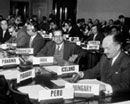 |
1 March 1958
United Nations Conference on the Law of the Sea, meeting of the Second Committee, Geneva, Switzerland
[Read more] |
1 March 1958
United Nations Conference on the Law of the Sea, meeting of the Third Committee, Geneva, Switzerland [Read more] |
1 March 1958
United Nations Conference on the Law of the Sea, meeting of the Fifth Committee, Geneva, Switzerland [Read more] |
1 March 1958
United Nations Conference on the Law of the Sea, meeting of the Fifth Committee, Geneva, Switzerland. [Read more] |
 |
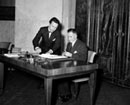 |
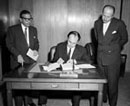 |
|
1 March 1958
United Nations Conference on the Law of the Sea, Palais des Nations, Geneva Switzerland
[Read more] |
30 April 1958
United Nations Conference on the Law of the Sea, Geneva, Switzerland
[Read more] |
31 October 1958
Signature of the four international conventions adopted by the United Nations Conference on the Law of the Sea, Office of the Legal Counsel,
United Nations Headquarters,
New York
[Read more] |
|
|













